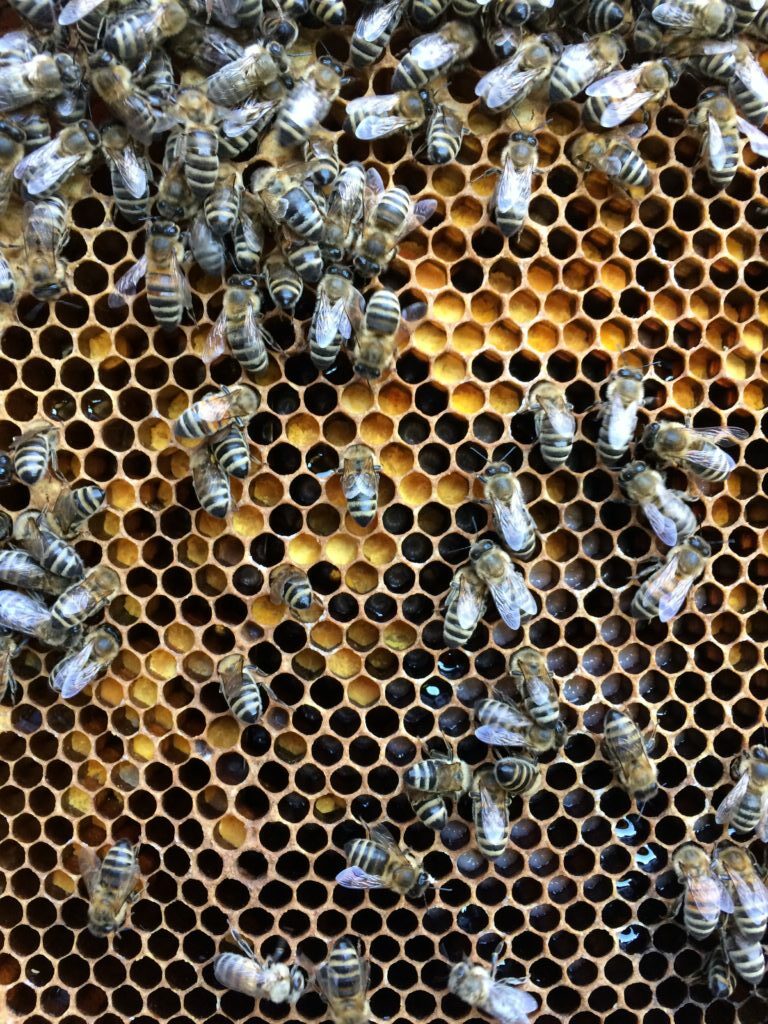Bees in the Olympus
Honey
The analysis of our summer honey usually shows that it is a single variety honey, to be exact a Lime tree (Tilia) Honey.
We sell our honey in the Bierstube and the GRAS. To our delight (and your pity) it sells like warm buns (german proverb).

Honey processing
We process our honey in the honey room in the old olympic mess building. Directly after the harvest we uncover the honeycombs, tumble them and store them in special barrels.
Depending on the honey's variety, we stir our honey creamy. For crystallised honey we have a heating cabinet to heat it without losses.
For preliminary determining the honey's variety we have microscopes. To definitively determine the variety we always send it to an external lab.
Last but not least, we pour our delicious honey in jars and label it.
Recipes
Honey-nut cereal bar
Christmasy fruit bread with honey
Pumpkin chutney with honey
Red beets carpaccio with honey vinaigrette
Cashew honey biscuits
Migration
In the last couple of years we migrated our bee colonies. For spring 2020 we chose a suitable rapeseed field, which blossoms from April to June and a forest for summer and autumn. The bee's job stays the same but you can taste the difference! Our goal was to offer rapeseed and forrest honey apart from our Lime honey. To taste a variety honey is a very special thing, as the name suggests, the pollen and nectar are mainly collected from the same plant. Forrest honey has the specialty that honeydew from lachnids and lac scales is collected.
A honey, according to german law, can only be named variety honey if it stems at least 60% from this source. The resulting individual aroma and specific quality yield an incomparable experience for your tastebuds.

Locations
Only the best for our girls: we had several locations for different needs.
Our main location is in the northern part of the olympic park. Now all our colonies reside here over the year. Our bees lavish on the fruit trees and shrubs in the area. Additionally they have different pollen and nectar sources such as Lavender. Be warned! Our girls will find your asparagus, too. In winter, the proximity allows us to monitor their health and intervene if needed.
In the olden times, our young colonies lived in the English Garden at the bee stand Biederstein. Here they grew in size and could put a spell on one or the other student. If two colonies do not get by with each other, one is stationed here.
For our marvellous rapeseed honey, we go south with our girls. In the last years we stationed them near Starnberg.
For a late harvest and for the exquisit forrest honey, we station our bees in a northwestern forrest around Munich.
Tours & Workshops
Until now small groups of students have accompanied us to our visits to the beehives. As the demand is so high, we have started to give guided tours for bigger groups. Here one can learn more about beekeeping and of course, bees.
Our tours are split up in several stations so we can go into detail with signs and placards.
The topics range from general informations about bees and colonies to the anatomy and life of the honeybee. You can learn more of the importance of the bee to nature and humanity, the bee calendar and fun facts. During our tour, we will show you what we do for preservation and how to protect wild bees specifically.
Of course we combine theory with application and let you handle a colony. For that we choose a colony that is very healthy and can handle an extra intrusion. In addition we can show you an exemplary box without bees and instead of honeycombs in the frame, we use pictures. This helps you to understand a beehive better without unnecessarily disturbing our bees.
If you haven't gotten enough, you then can visit our bee garden at the end of the U-alley and visit our honeyroom.
